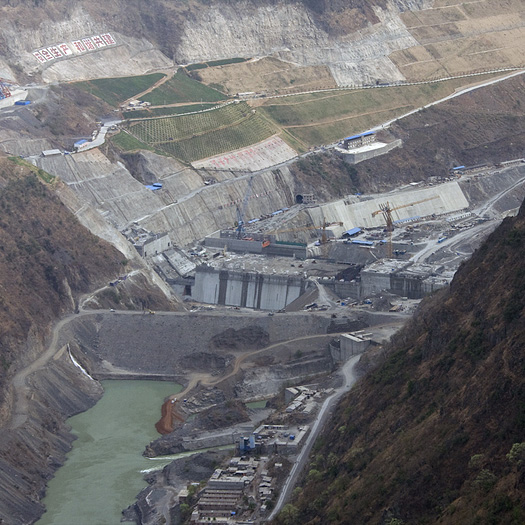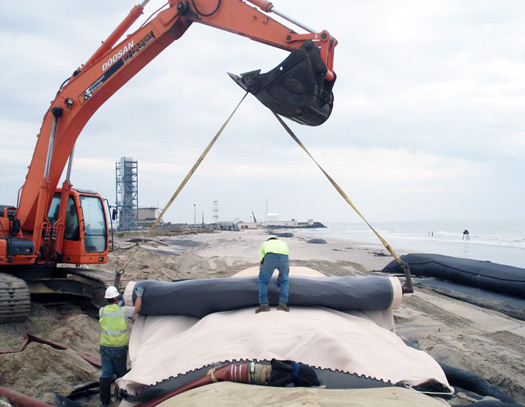
[Jinanqiao Dam under construction on the Jinsha River. New “mega-dams” such as Jinanqiao in high seismic risk zones — territories prone to earthquakes, in other words — are at the center of a highly consequential scientific debate about whether the dams are making disasters like catastrophic 2008 Wenchuan earthquake more likely and frequent. Fascinatingly, the argument is not between scientists who believe that the dam reservoirs are affecting regional seismicity at a massive scale and those who dispute that claim, but between scientists who argue that the dams produce only small, frequent tension-releasing quakes and those who believe that “reservoir-induced seismicity” includes the larger, catastrophic quakes. Roughly half of the 130 “mega-dams” recently built, currently under construction or proposed in China lie in within these high-risk zones. Photo by International Rivers.]
We’re excited to note that Making the Geologic Now — a fantastic collection of images and essays ruminating on the role of the geologic in shaping the present, edited by Elizabeth Ellsworth and Jamie Kruse (Smudge Studio/Friends of the Pleistocene) — will be launched next Tuesday, December 4th, with the release of the free, downloadable e-book at Punctum Books’ website, the launch of an interactive web version of the book, and a launch party hosted by Studio-X NYC. Pre-orders of the print version, which should ship in December, will also be available through Punctum’s website.
Making the Geologic Now announces shifts in cultural sensibilities and practices. It offers early sightings of an increasingly widespread turn toward the geologic as source of explanation, motivation, and inspiration for creative responses to material conditions of the present moment. In the spirit of a broadside, this edited collection circulates images and short essays from over 40 artists, designers, architects, scholars, and journalists who are extending our active awareness of inhabitation out to the cosmos and down to the Earth’s iron core. Their works are offered as test sites for what might become thinkable and possible if humans were to take up the geologic as our instructive co-designer—as a partner in designing thoughts, things, systems, and experiences. As a reading and viewing event, Making the Geologic Now is designed to move with its audiences while delivering signals from unfolding edges of the “geologic now.”
Elizabeth and Jamie have assembled a great and extremely diverse list of contributors, which I’ll copy and paste to avoid the difficult work of choosing who to mention:
Matt Baker, Jarrod Beck, Stephen Becker, Brooke Belisle, Jane Bennett, David Benque, Canary Project (Susannah Sayler, Edward Morris), Center for Land Use Interpretation, Brian Davis, Seth Denizen, Anthony Easton, Elizabeth Ellsworth, Valeria Federighi, William L. Fox, David Gersten, Bill Gilbert, Oliver Goodhall, John Gordon, Ilana Halperin, Lisa Hirmer, Rob Holmes, Katie Holten,Jane Hutton, Julia Kagan, Wade Kavanaugh, Oliver Kellhammer, Elizabeth Kolbert, Janike Kampevold Larsen, Jamie Kruse, William Lamson, Tim Maly, Geoff Manaugh, Don McKay, Rachel McRae, Brett Milligan,Christian MilNeil, Laura Moriarity, Stephen Nguyen, Erika Osborne, Trevor Paglen, Anne Reeve, Chris Rose, Victoria Sambunaris, Paul Lloyd Sargent, Antonio Stoppani, Rachel Sussman, Shimpei Takeda, Chris Taylor, Ryan Thompson, Etienne Turpin, Nicola Twilley, Bryan M. Wilson.

[A TenCate Geotube being unrolled and pumped full of sediment at the Mid-Atlantic Regional Spaceport on Wallops Island.]
Stephen and I also have a short piece in the collection, written with Tim Maly and Brett Milligan in our guise as the Dredge Research Collaborative. “Packaging Sludge and Silt” considers the geotube as a super-sized, Anthropocene-ready successor to the humble sandbag, and something of a small window into a new vernacular for engineered geology:
The geotube literally encapsulates the sublime materiality of the Dredge Cycle, as sediment and water in slurried suspension are stuffed into geotextile casings. The Dredge Cycle is fundamentally composed of wet stuff: basic materials; ordinary sand, silt, clay, and water. While it can and should be understood as a highly abstracted set of networks and feedback loops operating on a global spatial scale, it should also be understood as a material operation. It is the cubic yards of excavated soil downwashing across your backyard from the new construction three houses down in a rainstorm as much as it is globally networked processes the expansion of the Panama Canal to accommodate the importation of goods from East Asia driving port expansions and dredging operations along the East Coast of North America. Similarly, geotubes are always dirty: placed in muck, filled with muck, and, like muck, slumping and slouching into soft shapes, rather than following the precise angles of architectural geometry.
The geometry of the geotube, however, is no more natural than the clean modernist lines of the Hoover Dam. It is something else entirely, both post-natural and post-architectural. This seems entirely appropriate for an era in which we are freezing sediment-spraying rivers in specific configurations, like the Mississippi at Old River Control, or impounding the eroded sediments of entire continents behind vast concrete structures, like Three Gorges Dam. For an era where our largest monuments are not pyramids and skyscrapers, but geologic impacts.
The launch party, which is free and open to the public, will run from 7 to 9 pm on the 4th. Studio-X NYC is at 180 Varick Street in Manhattan.

